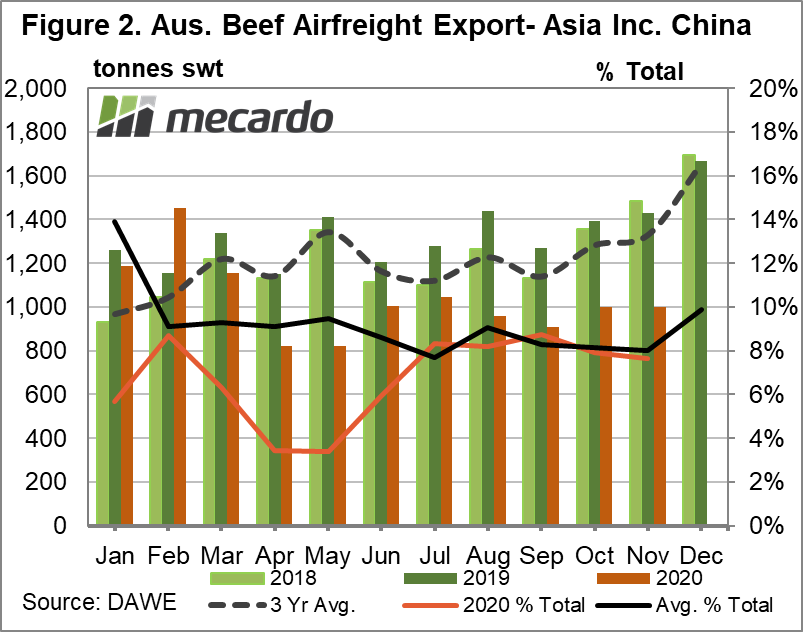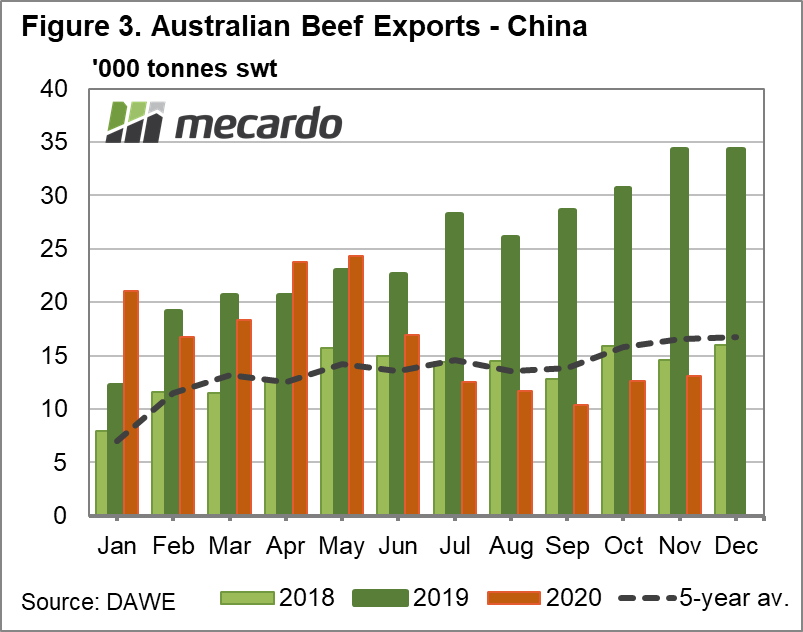Airfreight is an essential link in the beef supply chain to enable fast access to international markets and discerning customers that insist on the highest standards of freshness. Grounded international passenger planes caused airfreight prices to skyrocket for the export of fresh premium Australian beef, and without government assistance, such exports would be uneconomical. Here we take a look at the significance of this export category, and how well it is holding up to the challenges of 2020.
Airfreight has historically allowed Australia to feasibly supply premium markets where freshness is paramount, and those which prescribe low shelf life periods for meat, such as many parts of the Middle East, where chilled beef products are deemed to have a life of only 70-90 days, compared to the more usual 120 days. Growing demand for shelf-ready, pre-packaged chilled product for sale via retail channels has also driven growth in airfreighted beef.
In the last three years, 23-30kt of beef per year, equating to 2-3% of total Australian beef exports, was carried to its destination via airfreight (Figure 1). From 2017 to 2019 airfreight volumes increased by 25%. Around 50% of air freight volumes each month has headed for Asian markets, a large proportion of which can be attributed to China, meaning that the airfreight export channel represents up to 10% of total exports of Australian beef to China (Figure 2).
Approximately 45% airfreighted beef emanates from our biggest beef-producing state, Queensland.
The airfreight beef export route faced major headwinds during the early days of the COVID-19 crisis, when international borders closed and the passenger flights, upon which much of it relied to provide sufficient scale and volume for economically viable freight pricing, came to a standstill.
In March 2020, Jon Condon from Beef Central reported that rates for small consignment chilled airfreight to the key hub of Singapore had skyrocketed over 500%, from $1/kg to over $5/kg. Over April and May 2020, consignment volumes almost halved from prior levels due to extreme cost, and lack of capacity. However, the Australian government came to the rescue with the International Freight Assistance (IFAM) program to assist exporters. The scheme has allowed export volumes to be retained with funding of over $317 million committed to maintaining the scheme till June 2021.
In other good news for exporters, in response to product shortages and disruptions occurring over the COVID-19 period, in addition to a long-running lobbying and R&D campaigns by MLA; Kuwait, Jordan, Qatar, Saudi Arabia and Egypt all made temporary, and in some cases more long term concessions to extending mandatory shelf-life requirements to 120 days. This has the effect of making sea freight a more viable channel, taking some of the pressure off costly and limited airfreight capacity, however, MENA nations account for less than 20% of airfreighted beef exports.
Reports by consumer behaviour consultants China Skinny and Quantiful indicate that COVID-19 has caused Chinese consumers to seek out premium food products that have good reputations for health and freshness. These factors may have also helped support higher cost airfreight export volumes of fresh chilled beef into China. Despite this, monthly airfreighted beef volumes are 20-30% below average, particularly to Asian destinations which include China.
What does it mean?
International air passenger flight volumes, which are essential to achieving low-cost airfreight, are unlikely to recover to pre-pandemic levels for quite some time. If the IFAM freight assistance program is not extended beyond June 2021, the cost of premium airfreighted beef may become uncompetitive in the market. This could leave up to 2,000 tonnes a month in need of a new home, most likely at a substantially lower price point.
Have any questions or comments?
Key Points
- The airfreight channel typically only carries 2-3% of total Aussie beef exports
- Top destinations for airfreighted beef are the premium markets of Asia & China, the Middle East and the US.
- A $317m government IFAM subsidy will be available till the middle of 2021 to mitigate COVID-19 airfreight price rises so exporters can maintain market share.
Click on figure to expand
Click on figure to expand
Click on figure to expand
Data sources: DAWE, MLA, Queensland TIQ, Beef & Lamb NZ, Beef Central, Mecardo














